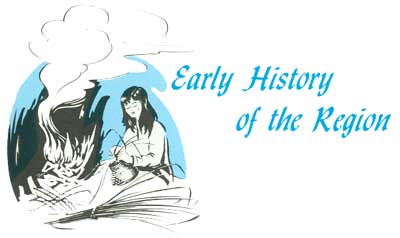
|
Geological Survey Bulletin 1508
The Geologic Story of Colorado National Monument |
EARLY HISTORY OF THE REGION

Prehistoric People
JOHN OTTO, early explorers, and even the Ute Indians who once hunted in the area were by no means the first people to view the Monument, in fact they were "Johnnies-come-lately." Considerable evidence indicates that prehistoric people inhabited the area thousands of years ago.
Many years ago Al Look, of Grand Junction, discovered and excavated two caves in the part of No Thoroughfare Canyon formerly outside the Monument. He found stone projectile points, knives, awls, milling stones, parts of a sandal and coiled basket, reed matting, corn, corncobs, acorns, and animal bones, but no pottery—indicating that the people had not progressed beyond basket making. Similar artifacts were found in several other nearby places on the Uncompahgre Plateau. Archaeologists have named this old culture the Uncompahgre Complex, and date it back to a few thousand years before the time of Christ.5 It should be pointed out that it is unlawful to remove artifacts, fossils, rocks, or minerals from a National Park or Monument.
5Wormington and Lister, 1956, p. 81, 119-122.
In the summer of 1963 an archaeological survey of Colorado National Monument was carried out, under the terms of an agreement between the National Park Service and the University of Colorado, by Stroh and Ewing and their field assistants.6 A total of 75 aboriginal sites were found of which 71 were within the Monument boundaries of that date, and 4 were closely adjacent. These comprised 41 open campsites, 24 rock shelters, 2 small caves, and 8 chipping stations. Artifacts recovered included 62 projectile points, 21 metates (grinding stones), 40 manos (hand stones), 111 whole or fragments of blades or scrapers, 6 choppers, several fragments of baskets, potsherds (bits of broken pottery) at two sites, 2 wood awls, several strands of yucca fibers, 3 corncobs, 6 kernels of corn, several bone fragments, storage cists at five sites, and petroglyphs at three locations.
6Archaeological survey of Colorado National Monument, 1963, by George Stroh, Jr., and George H. Ewing, with laboratory assistance by William D. Wade. Unpublished duplicated manuscript, 62 p., map, March 1964. For copies of this and other reports or discussions of the subject, or both, I am greatly indebted to: Adrienne Anderson, Regional Archaeologist, Rocky Mountain Region, National Park Service, Denver; Bruce Rippeteau, State Archaeologist, Denver; John Crouch, District Archaeologist, Bureau of Land Management, Grand Junction; H. Marie Wormington, Anthropologist Emeritus, Denver Museum of Natural History; and Al Look, Grand Junction. Copies of this and other unpublished reports referred to are on file at the headquarters of the Monument.
Stroh and Ewing concluded that the majority of the sites appear to have been the campsites of a hunting and gathering people, and they speculated that there may have been aboriginal activity in the area from as long as several thousand years ago to relatively recent times.

|
| PETROGLYPHS, on fallen slab of Wingate Sandstone in No Thoroughfare Canyon. Figure of man at lower right is about 6 inches high. The fading designs were traced with chalk before photographing them. Photograph by T. R. Giles, U.S. Geological Survey. (Fig. 4) |
The largest of the petroglyphs,7 or rock drawings, are on a fallen slab of Wingate Sandstone in No Thoroughfare Canyon, and are shown in figure 4. Archaeologist John Crouch (footnote 6), who kindly reexamined these petroglyphs in February 1980, told me that most of the figures appear to be Shoshonian (Ute), but that some may be of the Fremont culture8 or even older.
7Many of the cliff faces of the Wingate Sandstone, and in parts of the Plateau other sandstones also, are darkened or blackened by desert varnish, a natural pigment of iron and manganese oxides, silica, and clay. (See fig. 32.) The varnish is darker on cliff faces that have been standing longer. The prehistoric inhabitants of the canyon country learned that effective and enduring designs could be created simply by chiseling through the thin dark layer to reveal the buff, tan, or pink sandstone beneath. These petroglyphs were chiseled when the rock face was vertical; afterwards the slab fell to a horizontal position.
8The Fremont people were mainly hunters who roamed the Plateau around A.D. 850 or 900. (See Jennings, 1970.)

| <<< Previous | <<< Contents >>> | Next >>> |
bul/1508/sec3.htm
Last Updated: 8-Jan-2007